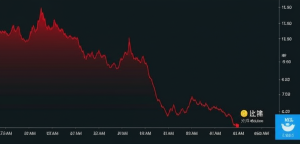
Navigating the Crossroads: Bitcoin’s Uptrend Faces a Possible Reversal
In the volatile world of cryptocurrencies, the mood can switch from euphoric to cautious in the blink of an eye. Bitcoin, often dubbed the digital gold, has recently bounced back from its April lows below $75,000, sparking excitement among traders and investors alike. However, technical indicators now caution that this rally might be at risk. The Bollinger Bands, a widely respected volatility and trend-following tool, suggest the possibility of a trend reversal. Understanding what this means requires a closer look at Bitcoin’s price dynamics, the role of Bollinger Bands, and the broader market influences at play.
—
Understanding Bollinger Bands and Their Signal Power
Bollinger Bands consist of a middle line (usually a simple moving average) flanked by two bands that represent standard deviations away — effectively capturing the price volatility. When prices ride along or “break out” beyond the upper band, the asset is considered potentially overbought, signaling a chance for a pullback. Conversely, if prices hug the lower band, the asset might be oversold.
In Bitcoin’s case, the recent price surge lifted it beyond typical ranges, stretching the upper Bollinger Band. This stretch implies volatility is high but could also mean that the momentum fueling the rally is reaching exhaustion. Traders observe these bands as a leading indicator: a sudden contraction or reversal within the bands often foreshadows a change in trend direction.
—
Bitcoin’s Recent Rally: A Closer Look
The April dip below $75,000 was a jolting moment, pulling Bitcoin back from its highs earlier in the year. The subsequent rebound was robust, driven by increasing interest from institutional investors, a general uptick in crypto adoption, and fresh momentum in related markets such as NFTs and decentralized finance.
However, such strong rallies can carry risks of overheating. The market might have priced in too much too fast. This creates a delicate balance: the need for sustained bullish catalysts versus the natural profit-taking behavior of traders. The Bollinger Bands’ signal that volatility is peaking suggests that the recent gains might be vulnerable to correction.
—
Layering Macro and Micro Factors
Bitcoin doesn’t move in isolation. It’s part of an ecosystem influenced by global economic news, regulatory landscapes, and technological trends.
– Macro Financial Environment: The Nasdaq’s recent decline amid geopolitical tensions in the Middle East and shifting Federal Reserve policies has triggered risk aversion in equity markets. Bitcoin, often called “digital gold,” sometimes acts as a hedge but can also mimic broader risk-off sentiments[1]. If the risk appetite diminishes, speculative assets including Bitcoin could experience downtrends.
– Crypto-Specific Developments: The rise of NFTs, DeFi, and omnichain structures persists, with projects like @untouchablesxyz promising innovation and hype waves in the NFT market[2]. Such developments often fuel investor interest in crypto assets, indirectly bolstering Bitcoin’s appeal.
– Volatility and Sentiment: Despite positive narratives, markets thrive on sentiment cycles. The sudden contraction in volatility signaled by Bollinger Bands hints that traders might soon pause, reassess, or even retreat, leading to increased price fluctuations.
—
What Could a Reversal Mean for Investors?
If Bitcoin’s price reverses, several scenarios unfold:
– Short-Term Correction: A pullback to more sustainable levels can reset market expectations, shake out weak hands, and lay the groundwork for a healthier long-term trend. It’s natural for fast-rising assets to undergo such corrections.
– Risk Mitigation Strategies: Investors may consider tightening stop-losses or diversifying into less volatile assets to navigate potential turbulence.
– Opportunity for Reaccumulation: Lower prices can entice new buyers and offer existing holders a chance to increase their positions at better valuations.
Understanding these possibilities allows investors to act with informed prudence rather than react impulsively to technical alarms.
—
Challenges in Relying Solely on Technical Indicators
While Bollinger Bands are a valuable tool, they are not infallible. Financial markets are complex, influenced by emotion, unexpected news, and regulatory shifts. Indicators can generate false positives or lag the actual trend changes.
For instance, Bitcoin’s volatility often results in multiple “false alarms” where the price seems to reverse but continues its trend. Therefore, coupling Bollinger analysis with other tools—such as volume trends, moving average crossovers, and macroeconomic signals—can provide a more comprehensive view.
—
The Road Ahead: Resilience or Reversal?
Bitcoin stands at a pivotal junction. The blend of high volatility, technical caution signals, and external market forces suggests the crypto giant’s next moves will be watched intensely across financial arenas.
For traders, this means balancing the thrill of rapid gains with strategic risk management. For casual investors, it underscores the importance of maintaining perspective amid market noise.
Ultimately, Bitcoin’s narrative remains dynamic—driven as much by technological innovation as by human psychology.
—
Closing Thoughts: Embracing Uncertainty with Clarity
Cryptocurrency markets thrive on a blend of innovation and unpredictability. The recent signals from Bollinger Bands nudge us to be alert: even robust uptrends can stumble. But rather than igniting panic, such warnings can inspire a disciplined approach to investing.
Bitcoin’s journey—marked by dramatic fluctuations and groundbreaking potential—reflects a broader lesson about financial markets: uncertainty is not a foe but a constant companion.
By interpreting technical indicators thoughtfully and contextualizing them within wider economic narratives, investors can navigate even the most volatile waters with greater confidence.
—
References
—
This report aims to distill the complex dance of Bitcoin’s price action and Bollinger Band signals in an accessible yet nuanced manner, equipping readers to perceive potential reversals not as mere disruptions but as integral stages in the market’s evolving story.








